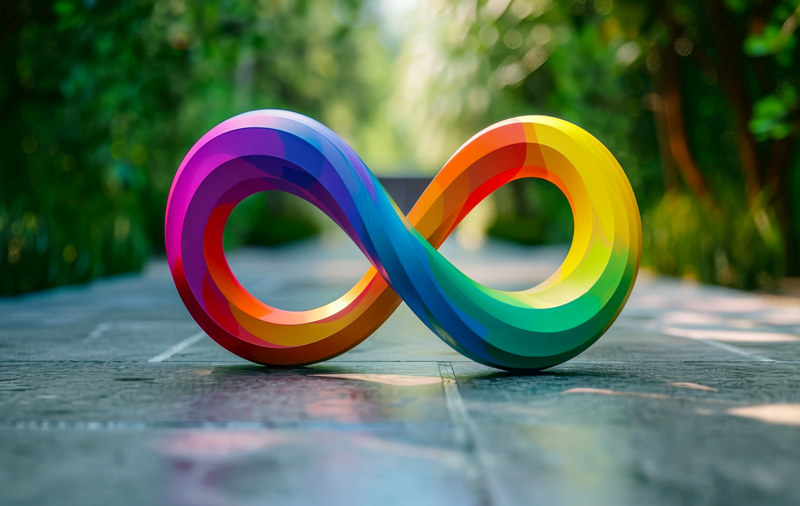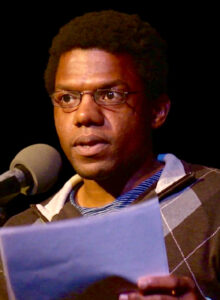Calling individuals neurodiverse spreads neurodiversity lite.
Neurodiversity lite is the pathology paradigm in disguise.
The pathology paradigm marginalizes/medicalizes neurominorities.
Using the word “neurodiverse” to refer to individual people spreads neurodiversity lite (Neumeier, 2018), an appropriative, performative paradigm that upends the neurodiversity paradigm. Everyone follows paradigms, though many of us don’t know which paradigms we follow. This can become a problem when we rely on paradigms that harm ourselves and those around us.

When it comes to the intertwined realities of disability and neurodivergence, most people default to the medical model of disability. The medical model isn’t completely harmful, as it lengthens and saves lives by diagnosing and treating illnesses. However, the medical model marginalizes neurominorities (cognitive minorities) because it frames innate neurodivergences as illnesses – “disorders” and conditions – and neurominorities as inherently broken.
Under the social model of disability, disability lies not solely within a person’s bodymind but within barriers within their environment: disability is a mismatch between a person’s bodymind and their environment. These barriers not only include physical and sensory barriers but also attitudinal barriers, such as the neuronormative, ableist attitudes that pervade society.
Neurodiversity lite is the medical model in disguise; it performs neuroinclusion, and sounds like people talking about “neurodiversities,” “neurodiverse conditions,” and referring to individual people as “neurodiverse.” This type of language may sound harmless, a simple matter of personal choice, but the opposite is true. The problem with the word neurodiverse lies not in its existence but in how neuronormative people use it: to refer to neurodivergent people, neurominorities. Calling a person neurodiverse is not only grammatically incorrect; it carries the pathology paradigm.
To pathologize someone is to determine that they are abnormal in some way, though “normal” people have never existed. Neurominorities have, historically and presently, been medicalized due to the pathology paradigm that pervades the Western world. According to Dr. Nick Walker, a neuroqueer academic and researcher, and professor of psychology at California Institute of Integral Studies, the pathology paradigm is defined by two assumptions: (1) there is only one healthy way for human minds to function (neurotypical) and (2) if your neurological functioning diverges from neurotypicality, then there’s something wrong with you (Walker, 2021). Under the pathology paradigm, there is something wrong with neurodivergent minds. Which means there is something wrong with the pathology paradigm.
In her book of essays, Neuroqueer Heresies, Walker notes that framing neurological minority groups in terms of pathology (as “disorders”) amounts to a cultural value judgment, not unlike drapetomania, a so-called psychological disorder that supposedly caused those enslaved in America to flee their enslavers – as if a person should appreciate slavery. Only in a capitalist-racist society would medical professionals construct a “disorder” like this. Similarly, queerness remained pathologized in the DSM as a mental “disorder” until 1987. Only in a heteronormative, queerphobic society would medical professionals construct a “disorder” like this. Only in a neuronormative, ableist society would someone create a so-called autism spectrum disorder.
This is often what neurodiversity lite sounds like: “Neurodiversity is the idea that neurological disorders like autism, ADHD, and dyslexia are normal neurological variations.” This kind of thinking that there is such a thing as a “disordered” mind and a “normal” mind opposes the neurodiversity paradigm, which sees all minds as natural and equal. Neurodiversity is, simply, the variety of all human minds; it’s a deeper level of diversity that’s been ignored for too long.
Under the neurodiversity paradigm, innate neurodivergences (non-neurotypical neurotypes) are not pathologies (or medical conditions) but are the natural way people see and experience the world. The neurodiversity paradigm doesn’t determine which minds are valuable and which are not. Everyone has neurology, which determines your thinking and behavior, and there is no normal or abnormal neurology any more than there are normal or abnormal skin colors or sexual orientations. Or anything. The concept of “normal,” like the concept of “race,” will never exist and only serves to perpetuate harmful paradigms like racial/ist ideology (Mason, 2024) and neurodiversity lite that endanger underrepresented humans.
Neurodiversity is often incorrectly framed as an umbrella term for neurodivergences. However, the word neurodiversity is not synonymous with neurodivergence. Neurodiversity: examine the word, a shortened form of “neurological diversity.” “Neuro” means “nerve” (the nervous system) and is short for “neurology,” which determines your thinking and behavior. “Diversity” means “variety.” The word “diverse” doesn’t mean “minority” – it means “various.” A single person cannot be diverse. So, a single person cannot be neurodiverse. “Diversity is a trait possessed by a group, not an individual,” writes Walker. “And to talk of individuals as neurodiverse is to situate them as ‘other’ to the norm” (Walker, 2020).
Human diversity involves all humans, just as biodiversity involves all living organisms on Earth. Neurodiversity is part of biodiversity, and, like biodiversity, neurodiversity is not a social construct but a natural phenomenon. Neurodiversity is all human minds. Everyone thinks differently.
Listen closely to messages that use “neurodiverse” to describe individual people and “neurodiversities” to describe neurodivergences, and you’ll hear the pathology paradigm, cloaked in neurodiversity lite: using the language of the neurodiversity paradigm and movement without understanding the true meanings of those terms. The term “neurodiverse” is often used to erase the terms “neurodivergent” and “neurominority,” logical constructs created by neurominorities to highlight the injustice they face as a result of neuronormativity: the belief that neurotypicality is the only proper way to think and behave – and the behaviors and practices that go along with this thinking.
By saying that neurodiversity is only about neurodivergences (so-called “neurodiversities”) neurodiversity lite (performative neurodiversity) excludes the neuromajority from the conversation, placing neurominorities in a separate box, segregating them, not unlike some “neurodiversity” hiring programs (GoingConcern, 2021). Neurodiversity lite has spawned an industry that looks like a pillar of the Autism Industrial Complex (AIC) (Broderick, 2021) – advanced by people who conflate neurodiversity with neurodivergence, (mis)using Autistic liberatory language to conceal harmful, neuronormative “therapies” like applied behavioral analysis (ABA). Such “therapies” attempt to condition the neurodivergence out of people, mostly young Autistic people who have little to no control over their lives. These compliance programs teach neurodivergent children to hate their core selves and to prize neurotypicality, often resulting in trauma. In identifying those who are responsible for spreading the pathology paradigm, Walker does not exclude Autistics:
The psychiatric establishment that classifies Autism as a “disorder”; the “Autism charity” that calls Autism a “global health crisis”; Autism researchers who keep coming up with new theories of “causation”; […] anyone who speaks of Autism using medicalized language like “symptom,” “treatment,” or “epidemic”; the mother who thinks that the best way to help her Autistic child is to subject him to Behaviorist “interventions” intended to train him to act like a “normal” child; the “inspiring” Autistic celebrity who advises other Autistics that the secret to success is to try harder to conform to the social demands of non-Autistics […] (pp. 18-19)
Autists developed the neurodiversity movement and the neurodiversity paradigm, making neurodiversity lite a form of cultural appropriation, 21st-century colonialism. While your misuse of the term “neurodiverse” may be unintentional, as my use of the word “neurodiversities” once was, back when I didn’t know any better, those who intentionally spread neurodiversity lite use the word “neurodiversity” as a pathologizing buzzword to erase the neurodiversity paradigm and profit from the appropriation of a necessary civil rights movement.
When used accurately, the word “neurodiverse” refers to a place that contains at least two people of different neurotypes. A household of neurotypical and Autistic family members would be a neurodiverse household, for example, whereas a household of purely neurotypical or purely Autistic people is not a neurodiverse household, as there is no neurological diversity in that home. These homes are neurologically homogenous (though neurominorities tend to be multiply neurodivergent, so a household of Autists would likely be a neurodiverse household).
Despite what you may have heard, the neurodiversity movement is not about erasing disability. It’s about refuting neuronormativity and the pathology paradigm; treating human minds the same way you’d treat any other form of human diversity, such as gender identity, religion, and skin color variances; focusing on the strengths of neurominorities while not disregarding neurodivergent disablement; refusing to see innate neurodivergences as pathological; helping to break down disabling barriers, including attitudinal barriers; and including the neuromajority (neurotypicals/neurotypicality) when talking about neurodiversity.
Promoting the neurodiversity paradigm sounds like talking about autism and other innate neurodivergences as neurotypes and cultural identities, like how you’d speak of queer identities. Promoting the neurodiversity paradigm also sounds like recognizing and accepting disability and neurodivergent cultures, including neurodivergences that are acquired rather than innate (traumatic brain injuries, post-traumatic stress), and emphasizing neurodivergent strengths without excluding the reality of our disabling barriers and need for support.
Keep in mind that the social model is intertwined with the neurodiversity paradigm, while the medical model is intertwined with the pathology paradigm. The neurodiversity paradigm exists to refute the pathology paradigm, which creates and maintains a hierarchy that dehumanizes neurominorities by prioritizing neurotypicality.
Whether knowingly or unknowingly, when you refer to neurominorities as “neurodiverse,” and when you refer to our neurotypes as “disorders,” you situate neurodivergent people as abnormal, pathological in some way, seen through a medicalized lens. Neurodiversity isn’t mainstream; its appropriative paradigm is mainstream. Despite the reality that neurodiversity includes all human minds, society is still unsafe for neurominorities, and the neurodiversity movement is needed to bring all human minds together to dismantle neuronormativity and the pathology paradigm so that neurominorities can live (better lives).
Bernard Grant is a writer. Learn more at their website BernardGrant.com.
References
Broderick, Alicia A. (2022). The Autism Industrial Complex. Myers Education Press.
Chown, N., Stenning, A., & Rosqvist, H. B. (2021). Neurodiversity studies: Mapping out possibilities of a new critical paradigm. Routledge.
GoingConcern. (2021, September 21). Here’s the Truth About What Really Happens at EY’s Neuro-Diverse Center of Excellence From Someone Who Was There. GoingConcern. https://www.goingconcern.com/ey-neurodiverse-center-of-excellence-experience/
Neumeier, Shain (2018, February 9). “To Siri With Love” and the Problem With Neurodiversity Lite. Rewire News Group. https://rewirenewsgroup.com/2018/02/09/siri-love-problem-neurodiversity-lite/
Sheena, Mason M. (2024). The Raceless Antiracist. Pitchstone Publishing.
Walker, Nick. (2021). Neuroqueer Heresies: Notes on the Neurodiversity Paradigm, Autistic Empowerment, and Postnormal Possibilities. Autonomous Press.
Walker, Nick. (2021, August 1). Throw Away the Master’s Tools: Liberating Ourselves from the Pathology Paradigm. Neuroqueer. neuroqueer.com/throw-away-the-masters-tools/
Walker, Nick. (2021, August 7). Autism and the Pathology Paradigm. Neuroqueer. neuroqueer.com/autism-and-the-pathology-paradigm/







I use my own term, “Neuro-unique,” which I think is more respectful and less pathologizing.
No offence, but I don’t like your term because under the tenets of the neurodiversity paradigm, everyone is neuro-unique, including neurotypical people, meaning your term could contribute to the continuing marginalisation of neurodivergent people by similarly dismissing the lived experience of autism by implying that everyone shares the same struggles.
I know exactly what you mean. You’re comparing the potential use of “neuro-unique” to the current reality where people say “We’re all a bit autistic, aren’t we?” as though their experiences as non-disabled neurotypical people could be in any way like those of my non-speaking autistic daughter, and I think you make a good point.
Using the word “neurodiverse” to refer to individual people…
TBH, I think the above would be better written as “Using the word ‘neurodiverse’ to refer to neurodivergent individuals and groups…” is not only more accurate and inclusive, but also contains a capsule lesson on how the word ‘neurodivergent’ should be used.